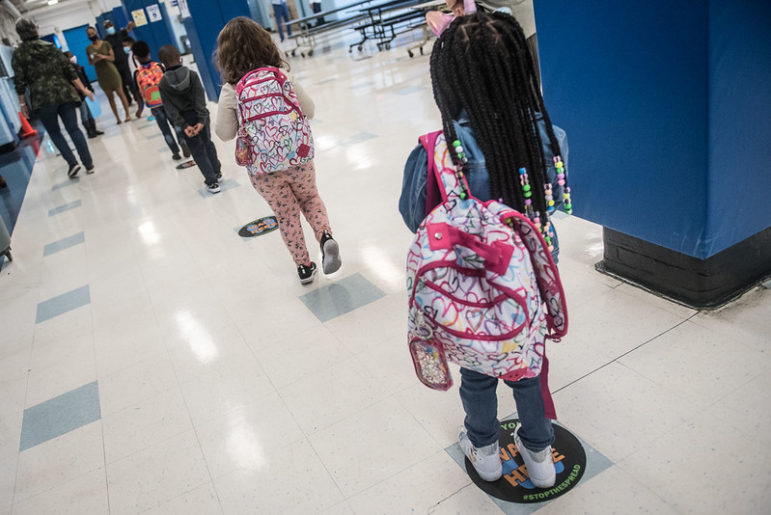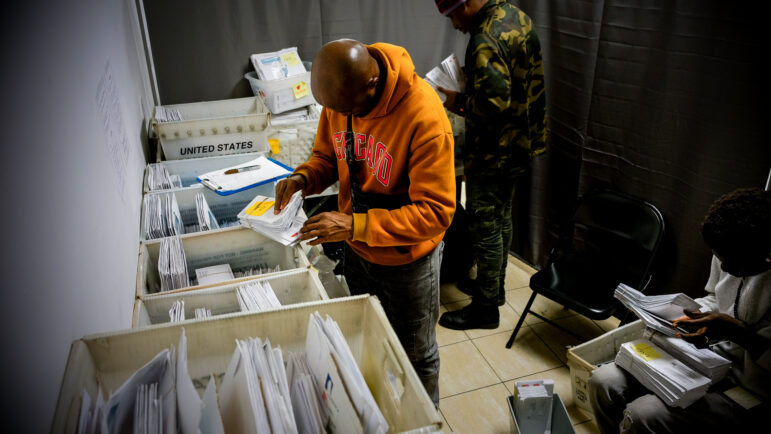‘I want our children to be good ancestors and citizens of the world, to see the beauty in all voices and stories. But to do that, they need to see diverse representation not just in their neighborhood, but in their school curriculum as well.’

Michael Appleton/Mayoral Photography Office
A scene from the first day of school in September at Manhattan’s P.S. 188.Years ago, I walked into my child’s New York City preschool classroom and was greeted by a wall of watercolor self-portraits, a patchwork of student faces splashed with colorful pastel backgrounds. My child, with his Anglican first name, his Italian middle name, and his Indian surname, depicted himself with deep chocolate brown skin, blending at the forehead into a mop of black hair. Most of the other faces were lighter toned, some yellows, peach, tan.
I was struck by the fact that already at four, my son was learning about race and difference, something I did not have to navigate in my more homogenous, white childhood. Here, in our neighborhood in Brooklyn, there are others like our children, mixes of races and cultures, for whom we mark the box “other” in racial categories. Within the city, my children see other mixed-race families, and when they were young I think I assumed that through osmosis they would understand they belong here. Now, I know that is not enough.
Growing up in New Jersey, I did not learn about Juneteenth, or that there was a Black National Anthem that was written a whole decade before the American National Anthem. I didn’t learn about the Chinese Exclusion Act until my graduate studies, which was also the first year I began teaching middle school. My favorite high school course was Non-Western Literature; it was the first time I read authors from Japan, Egypt, and India. The stories and voices felt valuable, and I wanted so much more of it, to open my world to other people and perspectives. That felt like real learning.
READ MORE: Overdue Assignment: Making NYC Schools Culturally Responsive
For my husband growing up in Kansas as the son of Indian immigrants, the absence of Asian voices in his curriculum caused him to stifle his Indian identity in public, to relegate his Indian culture and Sikh religion to the private world of home and family gatherings. He recalls that the only reference to Indian people that he heard in elementary school was that Christopher Columbus thought he was traveling to India, and therefore called Native Americans “Indians” upon his arrival in North America. The overwhelming message he learned was that white culture held space over his culture, so he worked hard to assimilate. We hope our children never have to hide parts of themselves to be accepted in the way he did.
 CityViews are readers’ opinions, not those of City Limits. Add your voice today!
CityViews are readers’ opinions, not those of City Limits. Add your voice today!
I’m grateful that one of the most meaningful lessons my children have had at their elementary school is to examine who is telling the stories they read, and look critically at whose voices may be left out of the story. I want our children to be good ancestors and citizens of the world, to see the beauty in all voices and stories. But to do that, they need to see diverse representation not just in their neighborhood, but in their school curriculum as well.
The current New York City public school English Language Arts (ELA) curriculum does not reflect the diversity of our city. According to a report from the NYC Coalition for Educational Justice, 84 percent of books in 10 commonly-used elementary school curricula are written by white authors and 51 percent have white main characters, despite the fact that 85 percent of the city’s public school students are Black, Latinx or Asian. The majority of our students are not seeing their cultures and languages reflected in their class books, which in turn, negatively affects their engagement with the curriculum.
This is why our schools need to commit to Culturally Responsive Sustaining Education, or CRSE. CRSE is a research-based approach to teaching that centers students, connecting their cultures, languages, and life experiences with what they learn in school. When students see themselves represented in the curriculum, they feel affirmed; they’re more likely to develop trust and relationships with teachers, and a sense of belonging builds self-confidence. CRSE helps students hone their critical thinking skills, leading to better outcomes in assessments. The goal of CRSE is to represent, honor, and empower students. Research demonstrates that culturally responsive education decreases dropout rates and suspensions for both students of color and white students, and increases grade point averages, student participation, self-image, critical thinking skills and graduation rates.
The New York State Education Department and the NYC Department of Education have committed to promoting a Culturally Responsive Sustaining Framework. The goal is to help educators create student-centered learning environments that: “affirm racial, linguistic and cultural identities; prepare students for rigor and independent learning, develop students’ abilities to connect across lines of difference; elevate historically marginalized voices; and empower students as agents of social change.” The DOE has stated a commitment to racial equity in schools, and this is a massive opportunity to change the way we reach students and families.
Right now our public schools are poised to receive an influx of funding, and there is debate over where to allocate that money. Some parents have voiced concerns over “learning loss” due to the COVID-19 pandemic, and wonder how our kids are going to catch up. One way to ensure growth and learning is to build bridges to our students’ communities through curricula that reflect their own experiences. Research has shown that children are more engaged, motivated and successful in school when academic learning connects with their lives, families, neighborhoods and cultures. If we want to address “ learning loss” then we need to dig in and learn to affirm who our students are. I want this for my children, and for all of our children.
Kate Singh is an educator and a New York City public school parent.









One thought on “Opinion: Curb Learning Loss at NYC Schools With a Culturally-Responsive Curriculum”
I need help my child is a good student but hasn’t received a descent start in school she has been called bad name from license professional teach and they even threating me and and her with child protection service we have never been disrespectful to the staff or children i need help found a parent advocate group that will help me and her this school year